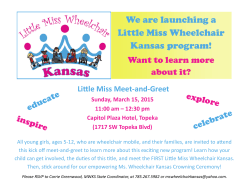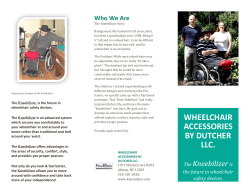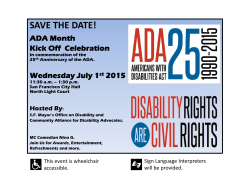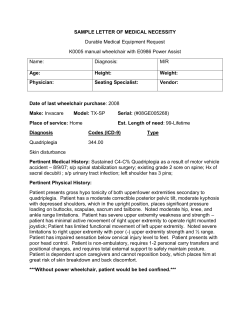
Hydraulic Hoist & Wheelchairs
kimberley individual and family support association inc POLICY ON HYDRAULIC VEHICLE HOIST and WHEELCHAIR RESTRAINTS The policy has been framed around eligibility criteria outlined in the Disability Services Act (1993) and Standard 8 of the Disability Services Standards (1993). Endorsed by the Board of KIFSA and signed by these representatives: NAME: NAME: NAME: NAME: POSITION: POSITION: POSITION: POSITION: CONTROLLED DOCUMENT Policy and Procedure – HYDRAULIC VEHICLE HOIST and WHEELCHAIR RESTRAINTS Policy No: 8.12 Date of Approval: February 2010 kimberley individual and family support association inc Revision Date: February 2012 Number of pages including cover: 4 PURPOSE AND SCOPE The following Procedure for the use of vehicle hoists is to be followed by all employees when loading and unloading wheelchair clients in and from KIFSA vehicles. The procedures follow KIFSA’s general commitment to safety for both clients and staff. KIFSA will provide training to all staff in the use of vehicle restraints and vehicle hoist operations. This policy and accompanying procedures are based on the Australian Standards AS 2942, AS1753 & AS1745 and supporting DSC guidelines “Reducing the Risk”. PROCEEDURE DEPLOYMENT OF HOIST 1. Open rear van door, ensuring that clients are approximately 2.5 metres away from the door. Be aware of surrounding traffic and other hazards. 2. Make sure that the rear van door is locked in the open position to prevent it from falling shut. 3. Clear area for the deployment of the hydraulic hoist. 4. Wheelchairs to be placed in the safest position to the vehicle. 5. Wheelchair brakes on and/or power off. 6. Ensure clients wheelchair restraint belts are in use. 7. Plus transport belts in use if provided i.e. yellow belt/ modular/clients or KIFSA’s. Also Thoracic Straps if required. 8. Press “DEPLOY” on hand control or the switch located on the arm of the hoist. 9. Press down on hand control (Use hand control on fixture in vehicle or on the arm of the hoist. LOADING 1. 2. 3. 4. 5. Load client in the wheelchair from the safest point near the hoist of wherever possible. Press deploy on hand control. Place removable step in position, shut side door of vehicle. Explain to clients what is happening. Be reassuring. Reduce speed around corners; although chairs are fastened securely, there is room for movement. kimberley individual and family support association inc 6. Load client in the wheelchair onto hoist, facing forwards (except under exceptional circumstances) 7. Apply wheelchair brakes or disengage power on electric wheelchair. Chair to be positioned correctly onto hoist. Enough clearance at the front to accommodate footplates and feet away from obstructions and the rear of the van. 8. Chair is to be forward enough for safety flaps to fold to ensure safety of wheelchair clients on loading. 9. DO NOT LEAVE CLIENTS IN A WHEELCHAIR UNATTENDED 10. Press up on hand control or switch located on arm of hoist. 11. STAFF ARE NOT TO RIDE UP OR DOWN ON HOIST AT THE SAME TIME AS A CLIENTS IN A WHEELCHAIR. 12. Staff are to follow the correct procedure at all times when using the hoist. Notify the Executive officer if there are any changes that need to be made to the procedure. ENTRY INTO VEHICLE 1. Release brakes of the wheelchair or re-engage power to electric wheelchair. 2. Move wheelchair half way into the van and apply brakes. Step up onto the hoist and move wheelchair further into the van. Return to the side door to apply front belts. 3. Manoeuvre wheelchair clients forwards into vehicle, or if able allow clients to move into the position you have allocated to them in the vehicle. 4. Place brakes on or disengage power again to ensure clients safety. 5. Staff member gains entry into vehicle from the side door. BELTS 1. Ensure wheelchair brake is on or power off. 2. Use the small grey and red floor wheelchair safety belt to secure front of wheelchair (red button to the front of vehicle) 3. STRAP AROUND FRAME of wheelchair once only if there is adequate room in the vehicle. 4. Ensure wheelchair belt is safely secured to the floor of vehicle. 5. After securing front grey straps pull chair back to ensure that straps are taut. Brakes on. 6. Place rear floor safety wheelchair belts directly behind wheelchair being secured. STRAP AROUND FRAME of wheelchair on the crossbars or any other solid part of the wheelchair, the highest point on the upright vertical pillar. (Not on the wheels or any other detachable part of the wheelchair). 7. Tension with metal levers on wheelchair floor safety belts. Secure in clasp. (See attached instructions for using 4-point Webbing Wheelchair Restraint) 8. Ensure that there is no movement in the wheelchair and that the wheelchair brakes are on and power disengaged where appropriate. 9. Place seatbelt around the waist of the consumer, ensuring that the belt is not twisted or restricted by any wheelchair encumbrances e.g. sidearm. kimberley individual and family support association inc 10. Adjust belt according to transport requirements. e.g. Buckle can be turned face down to prevent clients from undoing it inappropriately. 11. If wheelchair fitted with module strap adaptations ensure they are used. 12. ENSURE REMOVABLE STEP IS IN CORRECT POSITION AT ALL TIMES. UNLOADING – Reverse procedure of loading 1. Unbuckle all transport straps / modular straps removing any straps, which may prevent clear exit and store appropriately. 2. Deploy hoist into working position 3. Release brakes and engage power where appropriate. 4. Staff to position themselves in front of manual wheelchair clients and at power side of electric chair, if room permits. 5. Staff member needs to pull wheelchair backwards out of van, apply brakes, step off hoist, release brakes, pull back further onto hoist. Reapply brakes and press “down” on hand control. 6. Explain and reassure clients to what is happening. 7. Guide wheelchair partly onto hoist. 8. Put on brakes and/or disengage power. 9. If one staff, exit side door and go to back of van. Release brakes, engage power. Pull wheelchair fully onto hoist. 10. Reapply brakes and/or disengage power. 11. If two staff, first staff member to guide clients in wheelchairs partly onto hoist, second staff to pull or guide clients in wheelchairs fully onto hoist. 12. Reapply brakes and/or disengage power. 13. Lower hoist. Release brakes / engage power. 14. Remove wheelchair clients from hoist. 15. RAISE HOIST FOR NEXT TRANSFER IMMEDIATELY. 16. Staff not to stand directly behind hoist but to one side. 17. When taking clients off hoist ensure that the clients is placed in the safest position and that the wheelchair brakes applied and/or power disengaged. 18. STAFF SUPERVISION IS REQUIRED. DO NOT LEAVE WHEELCHAIR CLIENTS UNATTENDED. 19. STAFF ARE NOT TO TRAVEL ON HOIST TOGETHER WITH A CLIENTS IN A WHEELCHAIR. 20. All staff members need to be shown and instructed verbally with client in the wheelchair before they attempt the procedure themselves. MALFUNCTION OF HYDRAULIC HOIST 1. Check that flaps on hoist release. 2. Check position of red key on floor beside hoist. 3. Retrieve handle off rectangular black box. kimberley individual and family support association inc 4. Place handle in to red/green circle (opening facing in towards vehicle on black rectangular box. 1/4 turn to left to deploy and hoist will lower to ground by gravity. 5. 1/4 turn to right to fold up - this requires leaver again to be placed in red / green circle. 6. Pump until hoist folded and stored correctly. 7. Store handle in bracket on front of black box. BELT STORAGE 1. When not in use between wheelchair transfers, wheelchair belts to be placed in the least restrictive manner possible paired and fastened together and stored in storage compartment of vehicle or in centre. N.B. POWERGLIDE / GLIDE / ROLLERGLIDE WHEELCHAIR’S CAN BE TRANSPORTED IN A RECLINED POSITION
© Copyright 2025









